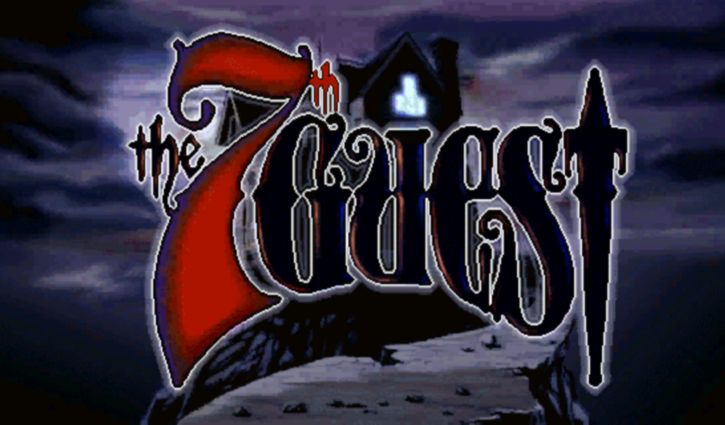Let me take you way back to 1993, when computers were just entering the mainstream, PC games came on floppy discs, and you didn’t know any better. What game could have possibly convinced the masses to abandon their beloved floppies and buy into that new-fangled, wacky “CD drive” nonsense? Well, Myst. But aside from Myst, there was a horror adventure puzzle game 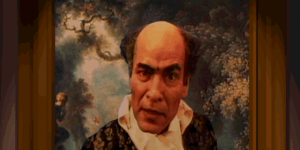 called the 7th Guest. The game contributed a lot to the rise of the CD-ROM, especially since it was the first game ever to be exclusive to the format. Even Bill Gates famously called it “the new standard in interactive entertainment.” Of course, that was 1993, and this is 2012.
called the 7th Guest. The game contributed a lot to the rise of the CD-ROM, especially since it was the first game ever to be exclusive to the format. Even Bill Gates famously called it “the new standard in interactive entertainment.” Of course, that was 1993, and this is 2012.
Point-and-click puzzles are a largely niche genre, and horror point-and-clicks are even more so. CD-ROMs, the format they worked so hard to introduce, have been phased out by DVDs, which themselves are starting to disappear with digital distribution. All the companies involved have long since bit the dust; however, Trilobyte, the original development company behind the game, miraculously rose from the dead two years ago to bring their old adventures back to iOS and PC for the first time since their original releases. But is it still a good game by today’s standards?
Let me start by explaining a bit about what exactly the 7th Guest is. The game revolves around a deranged, possibly possessed toymaker named Stauf, who builds a mysterious mansion with his riches. One night, he invites six guests to the mansion, and they are never heard from again. Sometime later, you get stuck in the mansion and must solve Stauf’s diabolical puzzles, encounter the spirits of the six previous guests, figure out the true events of what 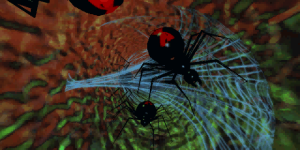
happened that night, and discover just who is the seventh guest.
The main game is structured around solving a puzzle in each room. Unlike most point-and-click games, The 7th Guest doesn’t bother with any sort of “use X on Y” gameplay. The interactive bits are all clearly marked by a change in cursor, so you know whether a click will activate a cut-scene, start a puzzle, or take you to a different room. By excluding these common adventure game tropes, the game takes a more Professor Layton-like approach, with each puzzle built as a very distinct brain teaser. Most of the time, these logical brain puzzles are hard, but quite fair. The hints provided by the protagonist and Stauf’s ghostly voice generally help to keep you on the right track, and the hint book in the library is a great, though slightly inconvenient, alternative to just Googling a walkthrough. Of course, there are exceptions; some puzzles are too easy, and some are downright horrible. Ever hear someone refer to a bad and unnecessary adventure game segment as a “soup can” puzzle? You have the kitchen in The 7th Guest to thank for that. For a worse example, look to the nigh-impossible microscope puzzle, which, hilariously enough, was easy back in the day, but, due to better AI, became increasingly challenging as computers were upgraded with faster CPUs (luckily ScummVM fixes this out of control AI, but it’s still near impossible to beat). The library definitely keeps things from getting too aggravating, but some of the puzzles are just downright unfair. Complicating this is the slow transitions between scenes. The animations run long and are cannot be skipped, so it’s pretty slow getting around the mansion or back down to the library for a hint. You need quite a bit of patience to appreciate this adventure.
The game is very non-linear, with the order of puzzle solving largely up to the player. This helps the mystery of the story quite a bit by presenting it in non-chronological bite-sized chunks. It’s up to you to piece together the various vignettes into the truth. However, the storytelling isn’t quite good enough to compliment the neat structure. I’ll be honest; the game can be pretty goofy. The ghosts are all FMV digitized actors plucked right out of a community theatre; the actors aren’t necessarily bad, but they are very theatrical and overwhelmingly hammy. Like most FMV games, the graphics don’t hold up very well at all. It’s all very fuzzy, pixelated, and kind of washed out. However, the rest of the game is all built in 3D models that, while not amazingly detailed, still look decent for 1993. All in all, the game doesn’t look good; older 3D-graphics just do not hold up the way 2D sprites do.
However, the goofiness occasionally becomes a point in favor of the game, because sometimes The 7th Guest just throws a huge, creepy curveball at you. The atmosphere is surprisingly well crafted, and the oldness occasionally works in the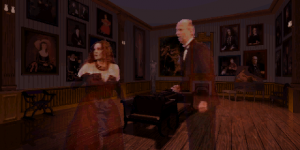 game’s favor. For example, the music is built entirely in MIDI format, and ranges from solemn violins to weird, upbeat, spooky electronica. It’s a very weird arrangement, where every so often a truly bizarre horn throws in a weird sharp note that, more than once, caught me off guard. Sometimes, the game just decides to play a random scream, drop a voice to satanic levels, or use Stauf’s famous “COME BAAAAAAACK!” line whenever you quit. There are also little bits of 3D animation you can encounter in the rooms. These range from overly silly moments, like dining room plates dancing around, to truly disturbing body horror moments, like a certain painting that does a certain thing in a certain place. There’s even a clown, which is perhaps the scariest clown I’ve ever encountered; that says something, because, as we all know, all clowns are horrifying, without exception.
game’s favor. For example, the music is built entirely in MIDI format, and ranges from solemn violins to weird, upbeat, spooky electronica. It’s a very weird arrangement, where every so often a truly bizarre horn throws in a weird sharp note that, more than once, caught me off guard. Sometimes, the game just decides to play a random scream, drop a voice to satanic levels, or use Stauf’s famous “COME BAAAAAAACK!” line whenever you quit. There are also little bits of 3D animation you can encounter in the rooms. These range from overly silly moments, like dining room plates dancing around, to truly disturbing body horror moments, like a certain painting that does a certain thing in a certain place. There’s even a clown, which is perhaps the scariest clown I’ve ever encountered; that says something, because, as we all know, all clowns are horrifying, without exception.
Though this might seem weird, the technological limitations wind up making the game even more unsettling. I noticed things like the fact that the poor sound quality gives everything a weird, otherworldly quality to voices, or that the use of
goofy, digitized actors make the occasional surprise scare from them even more pronounced (man, that clown…). The unsettling atmosphere was one of the best qualities of the original release, but the age and outdated nature of The 7th Guest
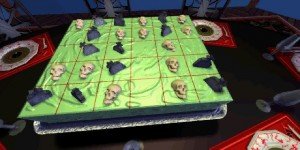 makes it even more unfamiliar, uncomfortable, and unsettling to a modern player.
makes it even more unfamiliar, uncomfortable, and unsettling to a modern player.
If this sounds like it’s up your alley, you should probably consider which edition to go for, as there’s a couple of important differences. The PC version, available at Good Old Games and DotEmu, is identical to the original release, but packaged under the excellent open-source ScummVM engine to ensure it works on modern rigs. The iOS version is universal for both iPhones and iPads, but removes the easy knife puzzle, the infuriating piano challenge, and the dreaded microscope game, due to “technical issues”, whatever those may be. There is a separate app for iPads that serves as a standalone version of the microscope puzzle, if you’re a glutton for punishment. The version offered by GOG is probably the most complete version, offering extra fun bonuses like the complete soundtrack, the original script, and an adorably dated making-of documentary that’s worth a look for dedicated fans. Of course, it is $9.99, double the price of the iOS edition. As one final addendum, you can download and run ScummVM on almost anything, so the PC version can easily run on a Mac or Linux machine if you copy the properly installed files over. I even tried installing The 7th Guest and ScummVM on my Android phone for kicks and giggles, and it ran perfectly. For flexibility and completeness, you definitely want the GOG release for this one.
Final Verdict: A straightforward, but very atmospheric adventure puzzler with mostly decent puzzles, and a few ragingly difficult ones. It has not aged well at all, which some may find charming and others annoying. If you’re someone who loves looking into the history of games, you’ll enjoy it quite a lot. Otherwise, you’re better off looking into a more modern point-and-click.
1993 Score:
Rating: 









Now Score:
Rating: 









This review is based on a review copy of the Good Old Games release of the 7th Guest.

